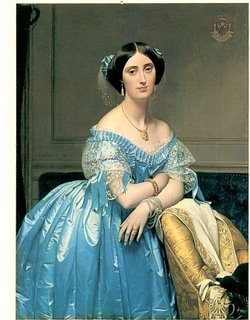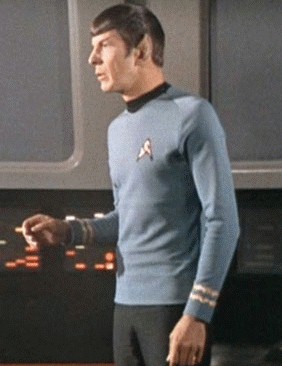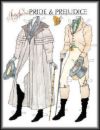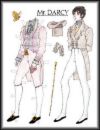
I have to admit, I’ve got nothin’ for my post today. I couldn’t come up with one single topic that was anything but totally boring. Maybe it’s the heat. It seems like at the end of summer, when it’s still hot (or very hot, as it is here–the temps have been in the triple digits for over two months straight now), and I’m longing for Fall but it’s nowhere in sight, I just get very lazy. It’s hard to concentrate on research and writing and work. One thing I’ve done far too much of in the last few days (okay, weeks) is read fashion magazines. I’m lusting for fall tweeds and boots and those cute cropped jackets, for dark lipstick and that elusive bottle of Chanel Black Satin nail polish (my new obsession).
So, I decided not to fight against my shallow current but go with it for this week’s post. I started wondering–who are some of the best-dressed women in literature? Some of the best descriptions of clothes and how they help define the womens’ characters? My method here was highly scientific–I scanned my bookshelves and pulled down books that I remembered as having some lovely fashions in them. Here’s what I found:
–Linda from Nancy Mitford’s The Pursuit of Love: Not just when she went to Paris and hooked up with Fabrice, who bought her that fab French wardrobe (“Linda had never before fully realized the superiority of French clothes to English. In London she had been considered exceptionally well-dressed…she now realized that never could she have had, by French standards, the smallest pretensions to chic”), but when she was a young deb, too. “Linda had one particularly ravishing ballgown made of masses of pale gray tulle down to her feet. Most of the dresses were still short that summer and Linda made a sensation whenever she appeared in her yards of tulle, very much disapproved of by Uncle Matthew, on the grounds that he had known three women burnt to death in tulle ball-dresses.”
–And Rose, Cassandra’s sister, in Dodie Smith’s I Capture the Castle (one of my favorite books from adolescence): Later Rose gets engaged to Simon (the object of Cassie’s crush), and has a vast and stylish trousseau, but I loved the girls’ early efforts, when they lived in “romantic” poverty. In an effort to make their clothes look new, they dye them all green, and Rose has their stepmother’s cast-off teagown, “it had been a faded blue, but dyed a queer sea-green…” I pictured it as a sort of tie-dyed mermaid dress!
–Flora, from Stella Gibbon’s Cold Comfort Farm: “Flora’s own dress was in harmonious tones of pale and dark green. She wore no jewels, and her long coat was of viridian velvet…Flora knew she did not look as beautiful as Elfine, but then she did not want to. She knew that she looked distinguished, elegant, and interesting. She asked for nothing more.” (In the great film adaptation, Flore wore in this scene not green but a sort of metallic-gold lace dress. Elfine still wore white satin, though)
–Of course, Holly Golightly from Truman Capote’s Breakfast at Tiffanys: “…she wore a slim cool black dress, black sandals, a pearl choker…there was a consequential good taste in the plainess of her clothes that made her, herself, shine so”
–Anna in Tolstoy’s Anna Karenina: “Anna was not in lilac, as Kitty had so urgently wished, but in a black, low-cut velvet gown…The whole gown was trimmed with Venetian lace. In her black hair was a little wreath of pansies, and there were more of the same in the black ribbon winding through the white lace encircling her waist…Now she {Kitty} understood that Anna could not have been in lilac, and that her charm was just that she always stood out from her attire, and that her dress could never be conspicuous on her. And the black dress, with its sumptuous lace, was not conspicuous on her; it was only the frame, and all that was seen was she–simple, natural, elegant, and at the same time gay and animated”
–And, from Girl of the Limberlost, Edith Carr (this was another favorite book when I was growing up, and, even though she wasn’t the heroine, I lusted after Edith’s ballgown at her engagement party. She bases her dress after a rare moth, the Yellow Imperial, that serves as a major plot point in the story): “…she stood tall, lithe, of grace inborn, her dark waving hair piled high and crossed by gold bands studded with amethysts and at one side an enameled lavender orchid rimmed with diamonds that flashed and sparkled. The soft yellow robe of lightest weight velvet fitted her form perfectly, while from each shoulder fell a great velvet wing lined with lavender, and flecked with embroidery of that color in imitation of the moth. Around her throat was a wonderful necklace and on her arms were bracelets of gold set with amethyst and rimmed with diamonds.”
And these are just a few. I left out Gone With the Wind, Wuthering Heights, and lots more. I didn’t even include any romances, because there are just too many (though a favorite is the green dragonfly-embroidered gown in For My Lady’s Heart, and the Maeve costume in Megan McKinney’s Lions and Lace). What are some of your favorite fashions in books, or stylish heroines?
 Tomorrow, I’m headed off to Worldcon — the 64th annual World Science Fiction Convention. There will be a couple thousand science fiction and fantasy authors, fans, illustrators, actors, and others there, including Connie Willis, Anne McCaffrey, Larry Niven, Garth Nix, and Madeleine E. Robins (author of the Regency-set Point of Honour and Petty Treason.) There will be Regency dancing, we’ll find out who won the Hugos this year (I got to vote!), and there will be panels with names ranging from “I’ll Pull Out Your Eyestalks and Stomp on Them” to “Should Californians be Farmers?” to “Writing While Holding Down a Day Job” to “The Slytherin Question.”
Tomorrow, I’m headed off to Worldcon — the 64th annual World Science Fiction Convention. There will be a couple thousand science fiction and fantasy authors, fans, illustrators, actors, and others there, including Connie Willis, Anne McCaffrey, Larry Niven, Garth Nix, and Madeleine E. Robins (author of the Regency-set Point of Honour and Petty Treason.) There will be Regency dancing, we’ll find out who won the Hugos this year (I got to vote!), and there will be panels with names ranging from “I’ll Pull Out Your Eyestalks and Stomp on Them” to “Should Californians be Farmers?” to “Writing While Holding Down a Day Job” to “The Slytherin Question.”









